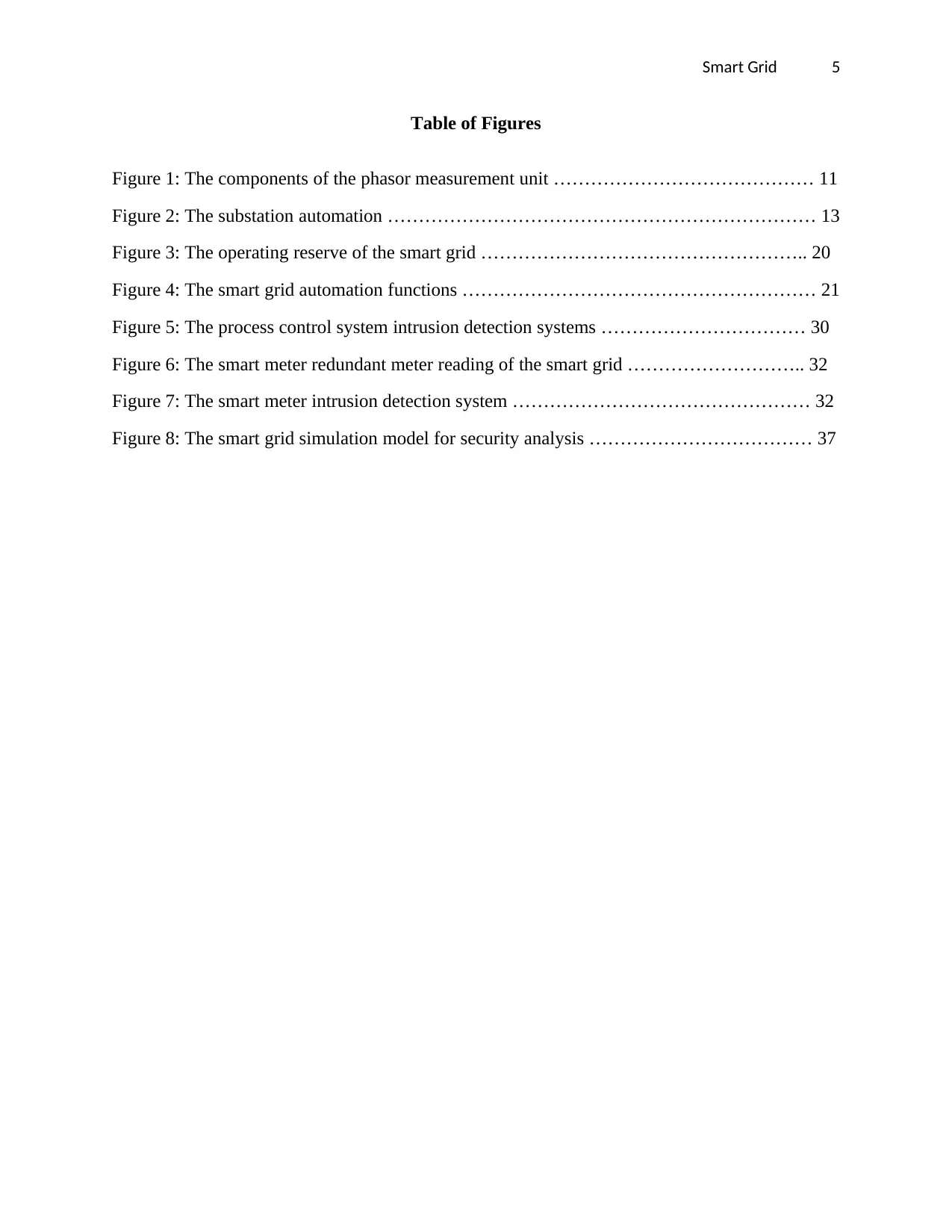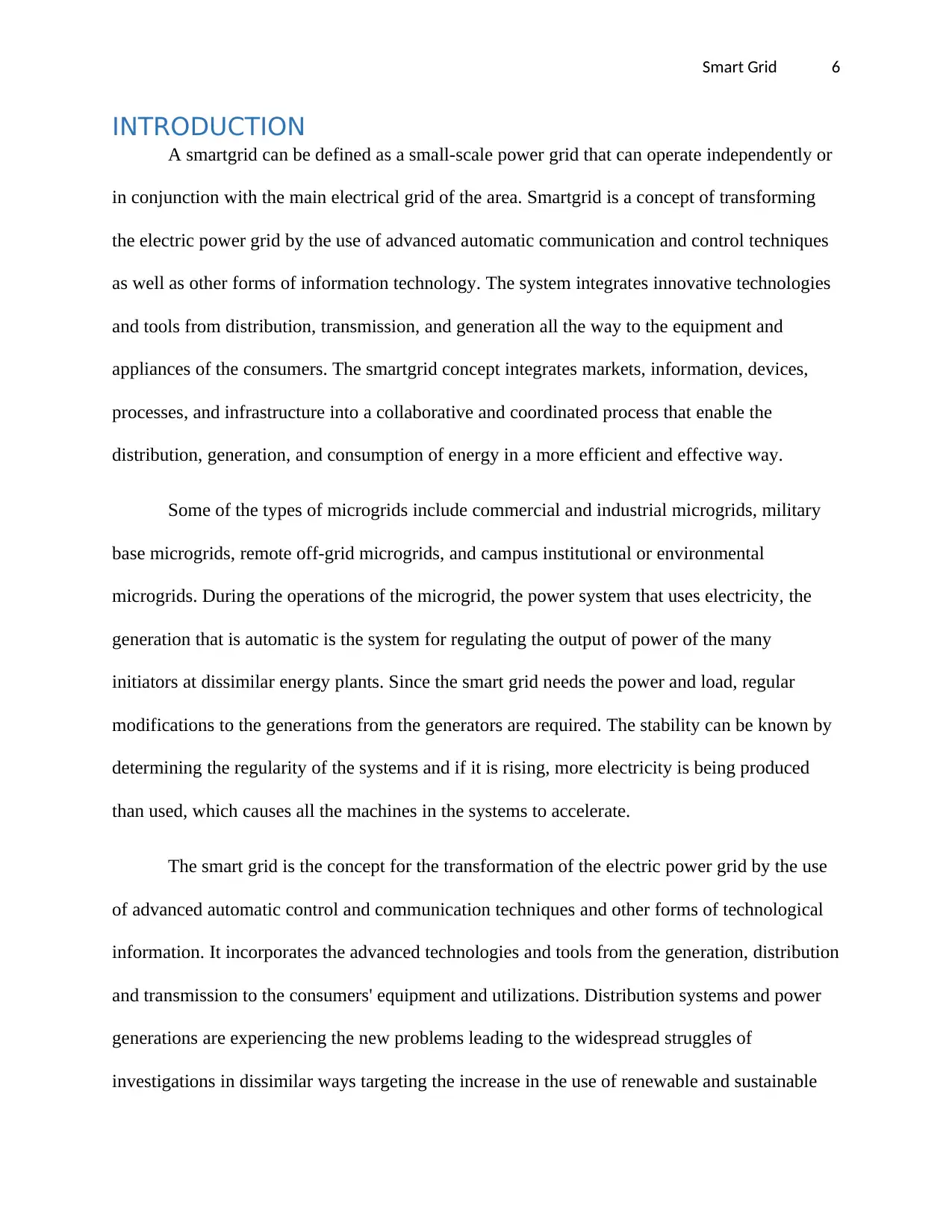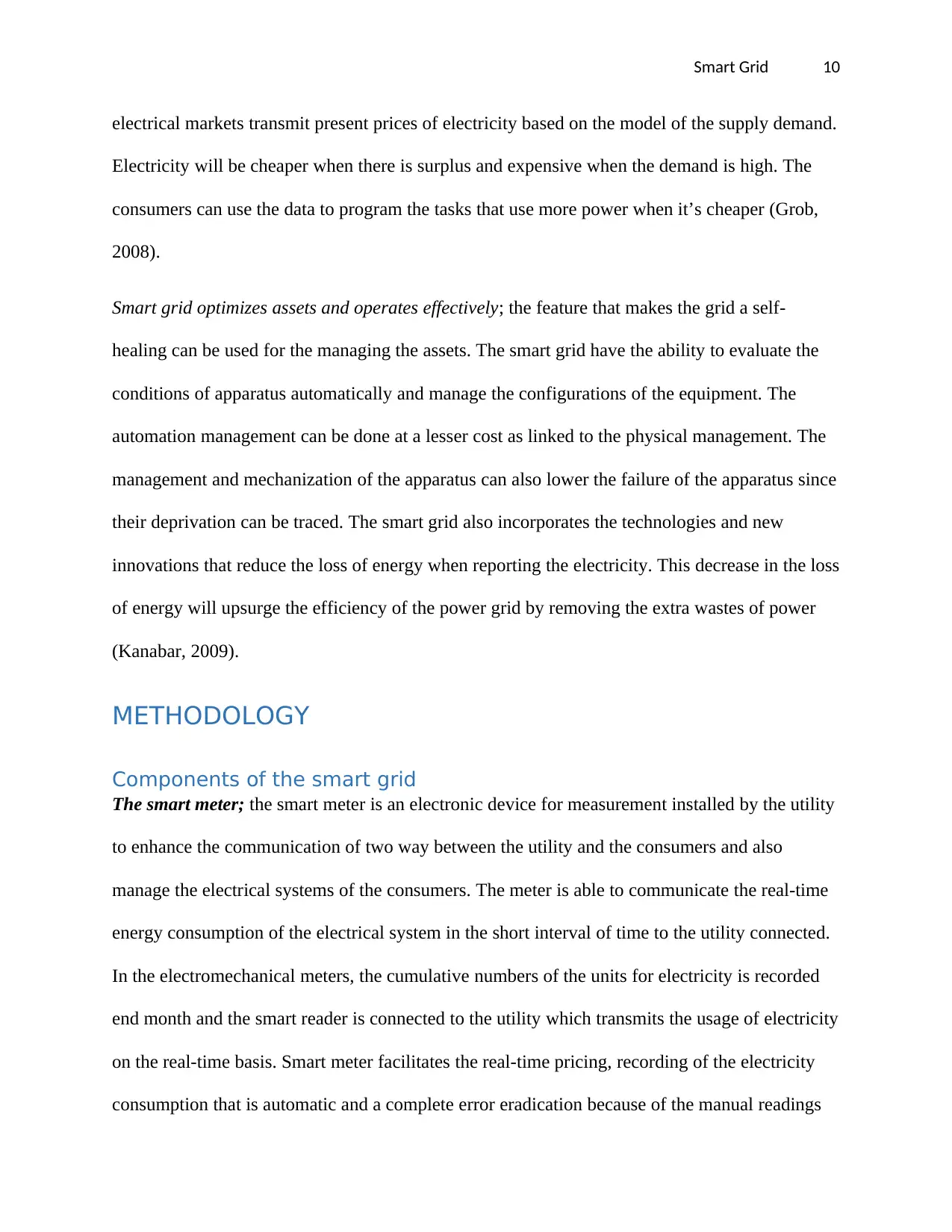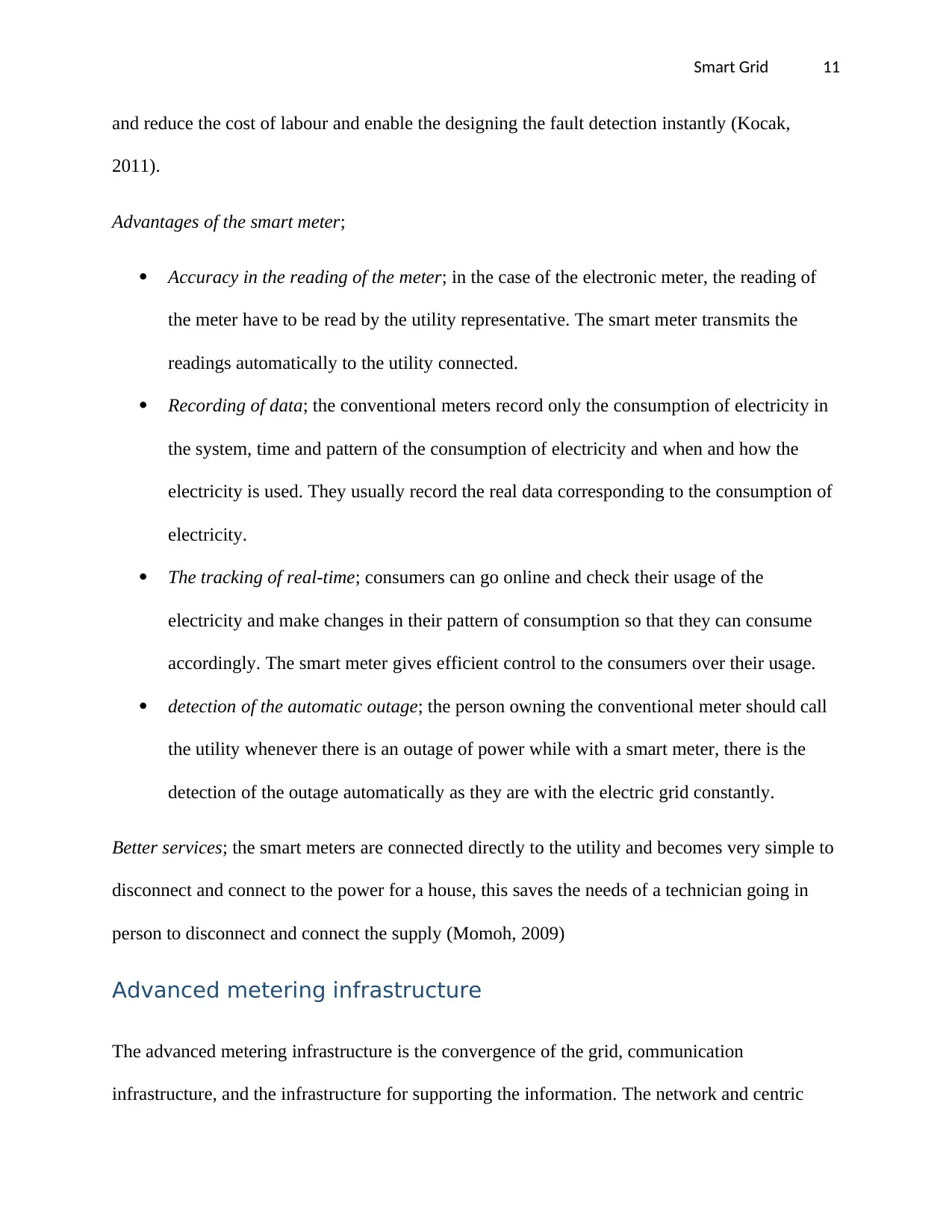Smart Grid Design and Analysis: Modernization of Electrical Grids
VerifiedAdded on 2023/06/12
|44
|11992
|336
Report
AI Summary
This research paper provides a comprehensive overview of smart grid design and analysis, focusing on the transformation of electric power grids through advanced automatic control, communication techniques, and information technology. It discusses key components such as advanced metering infrastructure, phasor management units, and substation automation, as well as advanced control methods and analytical tools. The paper explores the current and future states of smart grids, including the integration of renewable energy sources and the operation of smart grids with automatic generation control. It also addresses critical challenges such as storage systems and cyber security, highlighting potential threats and security requirements. The study emphasizes the importance of smart grids in enhancing energy efficiency, reducing costs, and promoting sustainability, making it a valuable resource for understanding modern power systems. Desklib provides access to this and other solved assignments to aid students in their studies.

Smart Grid 1
SMART GRID DESIGN AND ANALYSIS
A Research Paper on Smart Grid By
Student’s Name
Name of the Professor
Institutional Affiliation
City/State
Year/Month/Day
SMART GRID DESIGN AND ANALYSIS
A Research Paper on Smart Grid By
Student’s Name
Name of the Professor
Institutional Affiliation
City/State
Year/Month/Day
Paraphrase This Document
Need a fresh take? Get an instant paraphrase of this document with our AI Paraphraser

Smart Grid 2
ACKNOWLEDGEMENT
I would like to personally the Ausgrid and Australian Government for their detailed input in
providing the background information, Smart rid, Smart City trial data, operation of smart grid,
the current state of smart grid in the country, and also the future state of smart grid in the
country. This information were attained from numerous publications by these bodies which can
be accessed in areas such as Government libraries and internet sources. Its primary goal is to
provide the best quantity of information and the control of loads for the consumers, grid
operators and distributors to reduce the costs and the system demand while increasing the
efficiency of energy. In the future, the advanced control systems will be sophisticated and will
consider the national and regional perspective and will fully deploy the local ones throughout the
national grid.
ACKNOWLEDGEMENT
I would like to personally the Ausgrid and Australian Government for their detailed input in
providing the background information, Smart rid, Smart City trial data, operation of smart grid,
the current state of smart grid in the country, and also the future state of smart grid in the
country. This information were attained from numerous publications by these bodies which can
be accessed in areas such as Government libraries and internet sources. Its primary goal is to
provide the best quantity of information and the control of loads for the consumers, grid
operators and distributors to reduce the costs and the system demand while increasing the
efficiency of energy. In the future, the advanced control systems will be sophisticated and will
consider the national and regional perspective and will fully deploy the local ones throughout the
national grid.

Smart Grid 3
ABSTRACT
The concept of smart grid involves the transformation of the electric power grid by the
use of advanced automatic control and communication techniques and other forms of
technological information. The major aim of smart grid is to provide the best quantity of
information and the control of loads for the consumers, grid operators and distributors to reduce
the costs and the system demand while increasing the efficiency of energy. The superconducting
energy storage, compressed storage of energy and pumped hydroelectric all have the importance
as large central technologies for storing energy in smart grid. The smart meter security is the
problem since it is not difficult to gain access physically to the meter device and there is an
instant gain of money from the alteration of the systems.
The integrity of the meter device and the data must be confirmed in the smart grid before
their use. The availability, integrity and confidentiality are very important to this model. The
power system security is a problem because of the likelihood of getting the wrong data
involvement into the model. In the network of communication, the security attacks can be
grouped as a malicious user and the selfish misbehaving user. The selfish misbehaving user
attempt to get more network than the legitimate user by impious the protocol of communication.
The malicious users have no intent to benefit from their own, they obtain the information in the
network illegal. Different communication such a wireless and wired can be utilized to transmit
the data amongst electric utilities and smart meters.
ABSTRACT
The concept of smart grid involves the transformation of the electric power grid by the
use of advanced automatic control and communication techniques and other forms of
technological information. The major aim of smart grid is to provide the best quantity of
information and the control of loads for the consumers, grid operators and distributors to reduce
the costs and the system demand while increasing the efficiency of energy. The superconducting
energy storage, compressed storage of energy and pumped hydroelectric all have the importance
as large central technologies for storing energy in smart grid. The smart meter security is the
problem since it is not difficult to gain access physically to the meter device and there is an
instant gain of money from the alteration of the systems.
The integrity of the meter device and the data must be confirmed in the smart grid before
their use. The availability, integrity and confidentiality are very important to this model. The
power system security is a problem because of the likelihood of getting the wrong data
involvement into the model. In the network of communication, the security attacks can be
grouped as a malicious user and the selfish misbehaving user. The selfish misbehaving user
attempt to get more network than the legitimate user by impious the protocol of communication.
The malicious users have no intent to benefit from their own, they obtain the information in the
network illegal. Different communication such a wireless and wired can be utilized to transmit
the data amongst electric utilities and smart meters.
⊘ This is a preview!⊘
Do you want full access?
Subscribe today to unlock all pages.

Trusted by 1+ million students worldwide

Smart Grid 4
Contents
ACKNOWLEDGEMENT.................................................................................................................................2
ABSTRACT....................................................................................................................................................3
INTRODUCTION...........................................................................................................................................6
THE LITERATURE REVIEW OF THE SMART GRID...........................................................................................8
METHODOLOGY.........................................................................................................................................10
Components of the smart grid...............................................................................................................10
Advanced metering infrastructure.....................................................................................................11
Phasor management unit..................................................................................................................13
Substation automation......................................................................................................................14
Advanced control methods...................................................................................................................16
Current states........................................................................................................................................16
Distributed intelligent agents............................................................................................................18
Analytical tools......................................................................................................................................19
Operational application.........................................................................................................................20
THE FUTURE STATE OF SMART GRIDS.......................................................................................................21
Functions that the advanced control methods will perform in the future............................................21
OPERATION OF THE SMART GRID..............................................................................................................22
Operation reserve..................................................................................................................................22
Automatic generation............................................................................................................................23
Control and automation of a smart grid................................................................................................24
FAULTS AND CHALLENGES OF THE SMART GRID.......................................................................................26
Storage system for the smart grid.............................................................................................................28
Cyber security of the smart grid................................................................................................................32
Components of smart grid.....................................................................................................................32
Cyber security threats in the smart grid................................................................................................39
The smart grid communication security................................................................................................40
Requirements of the smart grid................................................................................................................42
CONCLUSION.............................................................................................................................................43
REFERENCES..............................................................................................................................................44
Contents
ACKNOWLEDGEMENT.................................................................................................................................2
ABSTRACT....................................................................................................................................................3
INTRODUCTION...........................................................................................................................................6
THE LITERATURE REVIEW OF THE SMART GRID...........................................................................................8
METHODOLOGY.........................................................................................................................................10
Components of the smart grid...............................................................................................................10
Advanced metering infrastructure.....................................................................................................11
Phasor management unit..................................................................................................................13
Substation automation......................................................................................................................14
Advanced control methods...................................................................................................................16
Current states........................................................................................................................................16
Distributed intelligent agents............................................................................................................18
Analytical tools......................................................................................................................................19
Operational application.........................................................................................................................20
THE FUTURE STATE OF SMART GRIDS.......................................................................................................21
Functions that the advanced control methods will perform in the future............................................21
OPERATION OF THE SMART GRID..............................................................................................................22
Operation reserve..................................................................................................................................22
Automatic generation............................................................................................................................23
Control and automation of a smart grid................................................................................................24
FAULTS AND CHALLENGES OF THE SMART GRID.......................................................................................26
Storage system for the smart grid.............................................................................................................28
Cyber security of the smart grid................................................................................................................32
Components of smart grid.....................................................................................................................32
Cyber security threats in the smart grid................................................................................................39
The smart grid communication security................................................................................................40
Requirements of the smart grid................................................................................................................42
CONCLUSION.............................................................................................................................................43
REFERENCES..............................................................................................................................................44
Paraphrase This Document
Need a fresh take? Get an instant paraphrase of this document with our AI Paraphraser

Smart Grid 5
Table of Figures
Figure 1: The components of the phasor measurement unit …………………………………… 11
Figure 2: The substation automation …………………………………………………………… 13
Figure 3: The operating reserve of the smart grid …………………………………………….. 20
Figure 4: The smart grid automation functions ………………………………………………… 21
Figure 5: The process control system intrusion detection systems …………………………… 30
Figure 6: The smart meter redundant meter reading of the smart grid ……………………….. 32
Figure 7: The smart meter intrusion detection system ………………………………………… 32
Figure 8: The smart grid simulation model for security analysis ……………………………… 37
Table of Figures
Figure 1: The components of the phasor measurement unit …………………………………… 11
Figure 2: The substation automation …………………………………………………………… 13
Figure 3: The operating reserve of the smart grid …………………………………………….. 20
Figure 4: The smart grid automation functions ………………………………………………… 21
Figure 5: The process control system intrusion detection systems …………………………… 30
Figure 6: The smart meter redundant meter reading of the smart grid ……………………….. 32
Figure 7: The smart meter intrusion detection system ………………………………………… 32
Figure 8: The smart grid simulation model for security analysis ……………………………… 37

Smart Grid 6
INTRODUCTION
A smartgrid can be defined as a small-scale power grid that can operate independently or
in conjunction with the main electrical grid of the area. Smartgrid is a concept of transforming
the electric power grid by the use of advanced automatic communication and control techniques
as well as other forms of information technology. The system integrates innovative technologies
and tools from distribution, transmission, and generation all the way to the equipment and
appliances of the consumers. The smartgrid concept integrates markets, information, devices,
processes, and infrastructure into a collaborative and coordinated process that enable the
distribution, generation, and consumption of energy in a more efficient and effective way.
Some of the types of microgrids include commercial and industrial microgrids, military
base microgrids, remote off-grid microgrids, and campus institutional or environmental
microgrids. During the operations of the microgrid, the power system that uses electricity, the
generation that is automatic is the system for regulating the output of power of the many
initiators at dissimilar energy plants. Since the smart grid needs the power and load, regular
modifications to the generations from the generators are required. The stability can be known by
determining the regularity of the systems and if it is rising, more electricity is being produced
than used, which causes all the machines in the systems to accelerate.
The smart grid is the concept for the transformation of the electric power grid by the use
of advanced automatic control and communication techniques and other forms of technological
information. It incorporates the advanced technologies and tools from the generation, distribution
and transmission to the consumers' equipment and utilizations. Distribution systems and power
generations are experiencing the new problems leading to the widespread struggles of
investigations in dissimilar ways targeting the increase in the use of renewable and sustainable
INTRODUCTION
A smartgrid can be defined as a small-scale power grid that can operate independently or
in conjunction with the main electrical grid of the area. Smartgrid is a concept of transforming
the electric power grid by the use of advanced automatic communication and control techniques
as well as other forms of information technology. The system integrates innovative technologies
and tools from distribution, transmission, and generation all the way to the equipment and
appliances of the consumers. The smartgrid concept integrates markets, information, devices,
processes, and infrastructure into a collaborative and coordinated process that enable the
distribution, generation, and consumption of energy in a more efficient and effective way.
Some of the types of microgrids include commercial and industrial microgrids, military
base microgrids, remote off-grid microgrids, and campus institutional or environmental
microgrids. During the operations of the microgrid, the power system that uses electricity, the
generation that is automatic is the system for regulating the output of power of the many
initiators at dissimilar energy plants. Since the smart grid needs the power and load, regular
modifications to the generations from the generators are required. The stability can be known by
determining the regularity of the systems and if it is rising, more electricity is being produced
than used, which causes all the machines in the systems to accelerate.
The smart grid is the concept for the transformation of the electric power grid by the use
of advanced automatic control and communication techniques and other forms of technological
information. It incorporates the advanced technologies and tools from the generation, distribution
and transmission to the consumers' equipment and utilizations. Distribution systems and power
generations are experiencing the new problems leading to the widespread struggles of
investigations in dissimilar ways targeting the increase in the use of renewable and sustainable
⊘ This is a preview!⊘
Do you want full access?
Subscribe today to unlock all pages.

Trusted by 1+ million students worldwide

Smart Grid 7
energy resources. The traditional smart grid depends on the fossil fuels which offer the power
option for the air emissions and leads to the load shaving peak and climate change while the
electronic smart grid uses the electricity hence reduced the impacts of climate change since there
are no emissions.
The technology of smart grid can support the incorporation of sources of renewable
energy in the future power systems. Its primary goal is to provide the best quantity of
information and the control of loads for the consumers, grid operators and distributors to reduce
the costs and the system demand while increasing the efficiency of energy. The concept of the
smart grid is associated naturally to the creation of the energy by the use of sources of renewable
energy as the smart grid promotes the social benefits like the lower cost of energy, reduced
emissions and larger flexibility to accommodate distributed new renewable energy sources.
These outcomes can be realized by the incorporation of various dissimilar technologies like
information and communication technology for making the demand for energy and creation more
controllable and predictable (Amin, 2005).
For 100 years and above, there has been no improvement on the simple electrical power
grid structure. To solve the complications of the prevailing power grid, a new idea of the smart
grid arose. Among the deficiency of the electrical power grid over the smart grid is the lack of
the computerized analysis, poor reflectiveness, lack of the awareness, the mechanical switches
causing the slow time responses. These have caused the blackouts for over forty years. Some of
the additional inhibitors are the high demographic growth and the request for energy, the failures
of equipment, climate change, problems of energy storage and reduction in fossil fuels. Also, the
emissions of greenhouse gases on environment have been a problem that is caused by the
energy resources. The traditional smart grid depends on the fossil fuels which offer the power
option for the air emissions and leads to the load shaving peak and climate change while the
electronic smart grid uses the electricity hence reduced the impacts of climate change since there
are no emissions.
The technology of smart grid can support the incorporation of sources of renewable
energy in the future power systems. Its primary goal is to provide the best quantity of
information and the control of loads for the consumers, grid operators and distributors to reduce
the costs and the system demand while increasing the efficiency of energy. The concept of the
smart grid is associated naturally to the creation of the energy by the use of sources of renewable
energy as the smart grid promotes the social benefits like the lower cost of energy, reduced
emissions and larger flexibility to accommodate distributed new renewable energy sources.
These outcomes can be realized by the incorporation of various dissimilar technologies like
information and communication technology for making the demand for energy and creation more
controllable and predictable (Amin, 2005).
For 100 years and above, there has been no improvement on the simple electrical power
grid structure. To solve the complications of the prevailing power grid, a new idea of the smart
grid arose. Among the deficiency of the electrical power grid over the smart grid is the lack of
the computerized analysis, poor reflectiveness, lack of the awareness, the mechanical switches
causing the slow time responses. These have caused the blackouts for over forty years. Some of
the additional inhibitors are the high demographic growth and the request for energy, the failures
of equipment, climate change, problems of energy storage and reduction in fossil fuels. Also, the
emissions of greenhouse gases on environment have been a problem that is caused by the
Paraphrase This Document
Need a fresh take? Get an instant paraphrase of this document with our AI Paraphraser

Smart Grid 8
transportation and electricity. Therefore, the new grid was required to solve all these problems
and to recognize the abilities the smart grid emerged (Amin, 2005).
THE LITERATURE REVIEW OF THE SMART GRID
The smart grid is an improvement of the existing electrical power grid. The advancement is in
the reaction to varying the necessities of the consumers. Numerous safety of cyber is presented in
the smart grid. In this section of literature reviews, storage systems, operation, cybersecurity are
discussed (Amin, 2005).
Characteristics of smart grid
The smart grid have a property of self-healing; it can adjust and redirect the electricity flow in
the time that the path of electrical transmission is disturbed. This is carried out by the self-
assessment of the power system state which is continuous hence major blackouts and their
frequencies can be reduced. When the number of the blackouts are reduced the economic losses
are also reduced (Bazzaco, 2010).
The smart grid includes and motivates customers; there is slight interface among the suppliers
and customers in the electrical power system. Smart grid gives the customer with more opinions
and information about their electrical power hence will enable the consumers to make a good
decision about their use of power that saves their money and promotes the competition amongst
suppliers of power. This happens by allowing the communication of two way between the
suppliers and customers. The smart grid also can cooperate with the electrical applications in the
home of the customer which allows the appliances to plan their runtime when the power is at its
lowest price (Crovella, 2003).
transportation and electricity. Therefore, the new grid was required to solve all these problems
and to recognize the abilities the smart grid emerged (Amin, 2005).
THE LITERATURE REVIEW OF THE SMART GRID
The smart grid is an improvement of the existing electrical power grid. The advancement is in
the reaction to varying the necessities of the consumers. Numerous safety of cyber is presented in
the smart grid. In this section of literature reviews, storage systems, operation, cybersecurity are
discussed (Amin, 2005).
Characteristics of smart grid
The smart grid have a property of self-healing; it can adjust and redirect the electricity flow in
the time that the path of electrical transmission is disturbed. This is carried out by the self-
assessment of the power system state which is continuous hence major blackouts and their
frequencies can be reduced. When the number of the blackouts are reduced the economic losses
are also reduced (Bazzaco, 2010).
The smart grid includes and motivates customers; there is slight interface among the suppliers
and customers in the electrical power system. Smart grid gives the customer with more opinions
and information about their electrical power hence will enable the consumers to make a good
decision about their use of power that saves their money and promotes the competition amongst
suppliers of power. This happens by allowing the communication of two way between the
suppliers and customers. The smart grid also can cooperate with the electrical applications in the
home of the customer which allows the appliances to plan their runtime when the power is at its
lowest price (Crovella, 2003).

Smart Grid 9
The smart grid is resilient to natural disaster and attacks; the smart grid is resistant to physical
outbreaks and cyber-attacks. The power grid is the critical tool and damaging it can have
dangerous effects on the welfare of the society.
The smart grid provides an increase in the quality of the electrical power; the electricity is
needed to be available every time from the power grid and also retain an endless voltage. Some
of the procedures of manufacturing are very delicate to the deviations of voltages. A dip in the
voltage can have the same problems as power loss on the industrial processes. These voltage
fluctuations can cause the loss of productivity (Divan, 2006).
The smart grid accommodates all the storage and generation choices available; the
incorporation of the renewable resources into the power grid has many implications. The present
power grid is the model of transmission premeditated to permit the flow of electricity of one way
to the consumers from single source of generation. The renewable sources of energy are
normally disconnected from the traditional power sources geographically, and when they are
combined into power grid it distributes sources of power. Subsequently the power grid was made
for the one source of power and not many different sources of power, this results to the
implications. The smart grid is able to support both new and traditional power sources (Godfrey,
2004).
The smart grid enables the electrical markets; the markets of electricity in the smart grid
enable competition between the dealers of the power. This competition will enable the providers
of the power to produce an efficient and cheap means of generating power. This lowers the
charges of electrical generating of power for the consumers as dealers compete for the
businesses. The smart grid also supports the disseminated sources of power, and this allows the
new power supplies and provides of the electrical services to enter the electrical markets. The
The smart grid is resilient to natural disaster and attacks; the smart grid is resistant to physical
outbreaks and cyber-attacks. The power grid is the critical tool and damaging it can have
dangerous effects on the welfare of the society.
The smart grid provides an increase in the quality of the electrical power; the electricity is
needed to be available every time from the power grid and also retain an endless voltage. Some
of the procedures of manufacturing are very delicate to the deviations of voltages. A dip in the
voltage can have the same problems as power loss on the industrial processes. These voltage
fluctuations can cause the loss of productivity (Divan, 2006).
The smart grid accommodates all the storage and generation choices available; the
incorporation of the renewable resources into the power grid has many implications. The present
power grid is the model of transmission premeditated to permit the flow of electricity of one way
to the consumers from single source of generation. The renewable sources of energy are
normally disconnected from the traditional power sources geographically, and when they are
combined into power grid it distributes sources of power. Subsequently the power grid was made
for the one source of power and not many different sources of power, this results to the
implications. The smart grid is able to support both new and traditional power sources (Godfrey,
2004).
The smart grid enables the electrical markets; the markets of electricity in the smart grid
enable competition between the dealers of the power. This competition will enable the providers
of the power to produce an efficient and cheap means of generating power. This lowers the
charges of electrical generating of power for the consumers as dealers compete for the
businesses. The smart grid also supports the disseminated sources of power, and this allows the
new power supplies and provides of the electrical services to enter the electrical markets. The
⊘ This is a preview!⊘
Do you want full access?
Subscribe today to unlock all pages.

Trusted by 1+ million students worldwide

Smart Grid 10
electrical markets transmit present prices of electricity based on the model of the supply demand.
Electricity will be cheaper when there is surplus and expensive when the demand is high. The
consumers can use the data to program the tasks that use more power when it’s cheaper (Grob,
2008).
Smart grid optimizes assets and operates effectively; the feature that makes the grid a self-
healing can be used for the managing the assets. The smart grid have the ability to evaluate the
conditions of apparatus automatically and manage the configurations of the equipment. The
automation management can be done at a lesser cost as linked to the physical management. The
management and mechanization of the apparatus can also lower the failure of the apparatus since
their deprivation can be traced. The smart grid also incorporates the technologies and new
innovations that reduce the loss of energy when reporting the electricity. This decrease in the loss
of energy will upsurge the efficiency of the power grid by removing the extra wastes of power
(Kanabar, 2009).
METHODOLOGY
Components of the smart grid
The smart meter; the smart meter is an electronic device for measurement installed by the utility
to enhance the communication of two way between the utility and the consumers and also
manage the electrical systems of the consumers. The meter is able to communicate the real-time
energy consumption of the electrical system in the short interval of time to the utility connected.
In the electromechanical meters, the cumulative numbers of the units for electricity is recorded
end month and the smart reader is connected to the utility which transmits the usage of electricity
on the real-time basis. Smart meter facilitates the real-time pricing, recording of the electricity
consumption that is automatic and a complete error eradication because of the manual readings
electrical markets transmit present prices of electricity based on the model of the supply demand.
Electricity will be cheaper when there is surplus and expensive when the demand is high. The
consumers can use the data to program the tasks that use more power when it’s cheaper (Grob,
2008).
Smart grid optimizes assets and operates effectively; the feature that makes the grid a self-
healing can be used for the managing the assets. The smart grid have the ability to evaluate the
conditions of apparatus automatically and manage the configurations of the equipment. The
automation management can be done at a lesser cost as linked to the physical management. The
management and mechanization of the apparatus can also lower the failure of the apparatus since
their deprivation can be traced. The smart grid also incorporates the technologies and new
innovations that reduce the loss of energy when reporting the electricity. This decrease in the loss
of energy will upsurge the efficiency of the power grid by removing the extra wastes of power
(Kanabar, 2009).
METHODOLOGY
Components of the smart grid
The smart meter; the smart meter is an electronic device for measurement installed by the utility
to enhance the communication of two way between the utility and the consumers and also
manage the electrical systems of the consumers. The meter is able to communicate the real-time
energy consumption of the electrical system in the short interval of time to the utility connected.
In the electromechanical meters, the cumulative numbers of the units for electricity is recorded
end month and the smart reader is connected to the utility which transmits the usage of electricity
on the real-time basis. Smart meter facilitates the real-time pricing, recording of the electricity
consumption that is automatic and a complete error eradication because of the manual readings
Paraphrase This Document
Need a fresh take? Get an instant paraphrase of this document with our AI Paraphraser

Smart Grid 11
and reduce the cost of labour and enable the designing the fault detection instantly (Kocak,
2011).
Advantages of the smart meter;
Accuracy in the reading of the meter; in the case of the electronic meter, the reading of
the meter have to be read by the utility representative. The smart meter transmits the
readings automatically to the utility connected.
Recording of data; the conventional meters record only the consumption of electricity in
the system, time and pattern of the consumption of electricity and when and how the
electricity is used. They usually record the real data corresponding to the consumption of
electricity.
The tracking of real-time; consumers can go online and check their usage of the
electricity and make changes in their pattern of consumption so that they can consume
accordingly. The smart meter gives efficient control to the consumers over their usage.
detection of the automatic outage; the person owning the conventional meter should call
the utility whenever there is an outage of power while with a smart meter, there is the
detection of the outage automatically as they are with the electric grid constantly.
Better services; the smart meters are connected directly to the utility and becomes very simple to
disconnect and connect to the power for a house, this saves the needs of a technician going in
person to disconnect and connect the supply (Momoh, 2009)
Advanced metering infrastructure
The advanced metering infrastructure is the convergence of the grid, communication
infrastructure, and the infrastructure for supporting the information. The network and centric
and reduce the cost of labour and enable the designing the fault detection instantly (Kocak,
2011).
Advantages of the smart meter;
Accuracy in the reading of the meter; in the case of the electronic meter, the reading of
the meter have to be read by the utility representative. The smart meter transmits the
readings automatically to the utility connected.
Recording of data; the conventional meters record only the consumption of electricity in
the system, time and pattern of the consumption of electricity and when and how the
electricity is used. They usually record the real data corresponding to the consumption of
electricity.
The tracking of real-time; consumers can go online and check their usage of the
electricity and make changes in their pattern of consumption so that they can consume
accordingly. The smart meter gives efficient control to the consumers over their usage.
detection of the automatic outage; the person owning the conventional meter should call
the utility whenever there is an outage of power while with a smart meter, there is the
detection of the outage automatically as they are with the electric grid constantly.
Better services; the smart meters are connected directly to the utility and becomes very simple to
disconnect and connect to the power for a house, this saves the needs of a technician going in
person to disconnect and connect the supply (Momoh, 2009)
Advanced metering infrastructure
The advanced metering infrastructure is the convergence of the grid, communication
infrastructure, and the infrastructure for supporting the information. The network and centric

Smart Grid 12
with lack of the composite across the industry are the motivations for its developments. The
problem to be addressed by the advance meeting infrastructure are normally new to the industry
of utility but the procedures for implementing the large scale, solutions of network-centric with
the high information assurance. The telecom, defense and cable industries can give more
examples of the requirements and standard that are applicable to its implementation (Morrow,
2010).
Advantages of advanced metering infrastructure;
Market applications; it serves to reduce the transportation, labour, and the cost of
infrastructure associated with the reading of the meter and maintenance.
Application to customers; it serves to increase the awareness to the customers about the
reduction of the load, reduction of the bad debts, improving the flow of cash and enhance
the satisfaction and convenience of the customers to provide the load management and
demand response for the system performance and reliability.
distribution operations; curtails the load of the customers for the management of the grid,
optimize the network based on the collected data, allow for the outages locations, and the
services restoration, improves the satisfaction of the customers with the reduced duration
of the outage and optimization of the distributed systems and generation management and
gives the responses to the emergency demand.
Control and monitoring extend the net to the delivery of pole-top transformers and to
consumers by the use of advanced metering infrastructure. More granular data field will
improve the efficiency and gives the data for other applications of the smart grids like the
management of outages. Advanced metering infrastructure enables the utilities to meet
the collection of the meter data, participation in the responses demands, and support the
with lack of the composite across the industry are the motivations for its developments. The
problem to be addressed by the advance meeting infrastructure are normally new to the industry
of utility but the procedures for implementing the large scale, solutions of network-centric with
the high information assurance. The telecom, defense and cable industries can give more
examples of the requirements and standard that are applicable to its implementation (Morrow,
2010).
Advantages of advanced metering infrastructure;
Market applications; it serves to reduce the transportation, labour, and the cost of
infrastructure associated with the reading of the meter and maintenance.
Application to customers; it serves to increase the awareness to the customers about the
reduction of the load, reduction of the bad debts, improving the flow of cash and enhance
the satisfaction and convenience of the customers to provide the load management and
demand response for the system performance and reliability.
distribution operations; curtails the load of the customers for the management of the grid,
optimize the network based on the collected data, allow for the outages locations, and the
services restoration, improves the satisfaction of the customers with the reduced duration
of the outage and optimization of the distributed systems and generation management and
gives the responses to the emergency demand.
Control and monitoring extend the net to the delivery of pole-top transformers and to
consumers by the use of advanced metering infrastructure. More granular data field will
improve the efficiency and gives the data for other applications of the smart grids like the
management of outages. Advanced metering infrastructure enables the utilities to meet
the collection of the meter data, participation in the responses demands, and support the
⊘ This is a preview!⊘
Do you want full access?
Subscribe today to unlock all pages.

Trusted by 1+ million students worldwide
1 out of 44
Related Documents
Your All-in-One AI-Powered Toolkit for Academic Success.
+13062052269
info@desklib.com
Available 24*7 on WhatsApp / Email
![[object Object]](/_next/static/media/star-bottom.7253800d.svg)
Unlock your academic potential
Copyright © 2020–2025 A2Z Services. All Rights Reserved. Developed and managed by ZUCOL.





